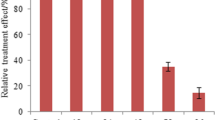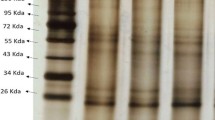Abstract
The "Huakang 2" silkworm variety, bred by the Sericulture Research Institute of the Chinese Academy of Agricultural Sciences, is highly resistant to Bombyx mori nucleopolyhedrovirus (BmNPV) and effectively solves the issue of frequent Bombyx mori nuclear polyhedrosis in sericultural production. The molecular mechanism of its resistance to BmNPV, however, is still unknown. The purpose of the present study was therefore to identify these anti-BmNPV mechanisms by using metabolomics in combination with transcriptomics after subcutaneous injection of budded virus (BV) with high concentrations of BmNPV from specimens of the Baiyu N variety (which is highly resistant to BmNPV) and the Baiyu variety (which is sensitive to BmNPV). A total of 375 differential metabolites were identified, which mainly included sugars, acids, amines, alcohols, glycosides, and other small molecules. KEGG enrichment analysis and functional clustering of differential metabolites identified possible metabolic pathways, including tyrosine metabolism, oxidative phosphorylation, and alanine, aspartate, and glutamate metabolism. The differentially expressed genes (DEGs) identified by transcriptome analysis were annotated in KEGG. Association analysis showed that the metabolic pathways of different silkworm varieties are affected differently by BmNPV infection, triggering a series of complex physiological and biochemical changes in the organism. In particular, oxidative phosphorylation might be an essential pathway involved in regulation of disease resistance.





Similar content being viewed by others
References
Xiang ZH (1994) Genetics and breeding for Bombyx mori. China Agriculture Press, Beijing
Xia QY, Wang J, Zhou ZY, Li RQ, Fan W, Cheng DJ, Cheng DJ, Qin JJ, Duan J, Xu HF, Li N (2008) Finishing the silkworm genome: insights into genome structure, gene evolution and biological process. Insect Biochem Mol Biol 38:1035–1046
Association CS (2018) China silk yearbook, vol 1. Zhejiang Sci-tech University Press, Hangzhou
Li JQ, Gu G (2013) Willingness of sericulture, risks of sericulture and countermeasures—based on a questionnaire survey of 1782 farmers in 91 counties in 14 provinces. Sericult Sci 39(02):355–364
Xu AY, Lin CQ, Qian HY, Sun PJ, Zhang YH, Liu MZ, Li L (2013) Breeding of silkworm species resistant to nuclear polyhedrosis virus “Hua Kang 2.” Sericulture Science 39(02):275–282
Qian HY, Li G, Li L, Zhao GD, Xv AY (2018) Development of SNP molecular markers based on a new variety of silkworm resistant blood-type sepsis. J Hebei Agric Univ 41(01):76–82
Li G, Qian HY, Luo XF et al (2016) Transcriptomic analysis of resistant and susceptible Bombyx mori following BmNPV infection provides insights into the antiviral mechanisms. J Genom 2:86346
Li G, Zhou KY, Zhao GD et al (2019) Transcriptome-wide analysis of the difference of alternative splicing in susceptible and resistant silkworm strains after BmNPV infection. 3 Biotech 9(4):152
Qian HY, Li G, Zhao GD, Liu MZ, Xu AY (2020) Metabolic characterisation of the midgut of Bombyx mori varieties after BmNPV infection using GC-MS-based metabolite profiling. Int J Mol Sci 21(13):4707
Chen TT, Tan LR, Hu N et al (2019) Specific genes related to nucleopolyhedrovirus in Bombyx mori susceptible and near-isogenic resistant strains through comparative transcriptome analysis. Insect Mol Biol 28(4):473–484
Savoi S et al (2016) Transcriptome and metabolite profiling reveals that prolonged drought modulates the phenylpropanoid and terpenoid pathway in white grapes (Vitis vinifera L.). BMC Plant Biol 16(1):67
Ma XS, Xia H, Liu YH, Wei HB, Zheng XG, Song CZ, Chen L, Liu HY, Luo LJ (2016) Transcriptomic and metabolomic studies disclose key metabolism pathways contributing to well-maintained photosynthesis under the drought and the consequent drought-tolerance in rice. Front Plant. https://doi.org/10.3389/fpls.2016.01886
Dong HL, Zhang SX, Tao H et al (2017) Metabolomics differences between silkworms (Bombyx mori) reared on fresh mulberry (Morus) leaves or artificial diets. Sci Rep 7:10972. https://doi.org/10.1038/s41598-017-11592-4
Vrieling F, Kostidis S, Spaink HP et al (2020) Analyzing the impact of Mycobacterium tuberculosis infection on primary human macrophages by combined exploratory and targeted metabolomics. Sci Rep 10(1):7085
Costello CA, Hu T, Liu M et al (2020) Differential correlation network analysis identified novel metabolomics signatures for non-responders to total joint replacement in primary osteoarthritis patients. Metabolomics 16(5):61
Kanehisa G (2000) KEGG: kyoto encyclopedia of genes and genomes. Nucleic Acids Res 28(1):27–30
Xia JG, Wishart DS (2010) MetPA: a web-based metabolomics tool for pathway analysis and visualization. Bioinformatics 18:2342–2344
Iwanaga M et al (2007) Identification of differentially expressed host genes in Bombyx mori nucleopolyhedrovirus infected cells by using subtractive hybridization. Appl Entomol Zool 42(1):151–159
Sagisaka A et al (2010) Genome-wide analysis of host gene expression in the silkworm cells infected with Bombyx mori nucleopolyhedrovirus. Virus Res 147(2):166–175
Chen KP, Huang JT, Yao Q (2014) Model organism Bombyx mori. Jiangsu Phoenix Science and Technology Press, Nanjing
Meng ZQ (1982) Studies on resistant heredity law of Bombyx mori to B. mori nucleopolyhedrovirus. Sci Sericul 8:133–138
Chen KP, Lin CQ, Yao Q (1996) Studies on the resistance to nuclear polyhedrosis virus (NPV) and its inheritance law in silkworm Bombyx mori. Sci Sericul 22:160–164
Watanabe H (2002) Genetic resistance of the silkworm, Bombyx mori to viral diseases. Current ence 83(4):439–446
Zafar B, Shabir AW, Malik MA et al (2018) A review: Disease resistance in mulberry silkworm Bombyx mori L. Asian J Sci Technol 4:157–166
Yao Q, Li MW, Wang Y, Wang WB, Lu J, Dong Y, Chen KP (2010) Screening of molecular markers for NPV resistance in Bombyx mori L. (Lep., Bombycidae). J Appl Entomol 127(3):134–136
Liu XY, Yao Q, Chen KP (2004) Studies on RAPD markers for NPV resistance in silkworm (Bombyx mori) using RAPD method. J Jiangsu Univ (Natl Sci Edn) 25(1):4
Feng F, Fu J, Hu P, Zhang X, Yao Q, Chen KP (2012) Genetic analysis of baculovirus resistance in lepidopteran model insect Bombyx mori L. Afr J Biotech 11(79):14417–14421
Wang XY, Yu HZ, Xu JP et al (2017) Comparative subcellular proteomics analysis of susceptible and near-isogenic resistant Bombyx mori (Lepidoptera) larval midgut response to BmNPV infection. Sci Rep 7:45690
Qin LG, Xia HC, Shi HF, Ya J (2012) Comparative proteomic analysis reveals that caspase-1 and serine protease may be involved in silkworm resistance to Bombyx mori nuclear polyhedrosis virus. J Proteomics 75(12):3630–3638
Hu XL, Zhu M, Wang SM, Zhu LY, Xue RY, Cao GL, Gong CL (2015) Proteomics analysis of digestive juice from silkworm during Bombyx mori nucleopolyhedrovirus infection. Proteomics 15(15):2691–2700
Acknowledgments
We would like to thank TopEdit (www.topeditsci.com) for English language editing of this manuscript.
Funding
This work was supported by the Key R&D Plan of Jiangsu Province (Modern Agriculture, BE2020418), the National Natural Science Foundation of China (no. 31802316), and the China Agriculture Research System of MOF and MARA.
Author information
Authors and Affiliations
Contributions
Conceived and designed the experiments: HYQ. Performed the experiment: HMG, XZ, MZL, GDZ. Analyzed the data: HYQ, HMG and GL. Wrote the paper: HYQ and GL.
Corresponding authors
Ethics declarations
Conflict of interest
The authors declare no conflict of interest.
Additional information
Handling Editor: Simona Abba'.
Publisher's Note
Springer Nature remains neutral with regard to jurisdictional claims in published maps and institutional affiliations.
Supplementary Information
Below is the link to the electronic supplementary material.
Rights and permissions
About this article
Cite this article
Qian, H., Guo, H., Zhang, X. et al. Metabolic characterization of hemolymph in Bombyx mori varieties after Bombyx mori nucleopolyhedrovirus infection by GC-MS-based metabolite profiling. Arch Virol 167, 1637–1648 (2022). https://doi.org/10.1007/s00705-022-05463-1
Received:
Accepted:
Published:
Issue Date:
DOI: https://doi.org/10.1007/s00705-022-05463-1




